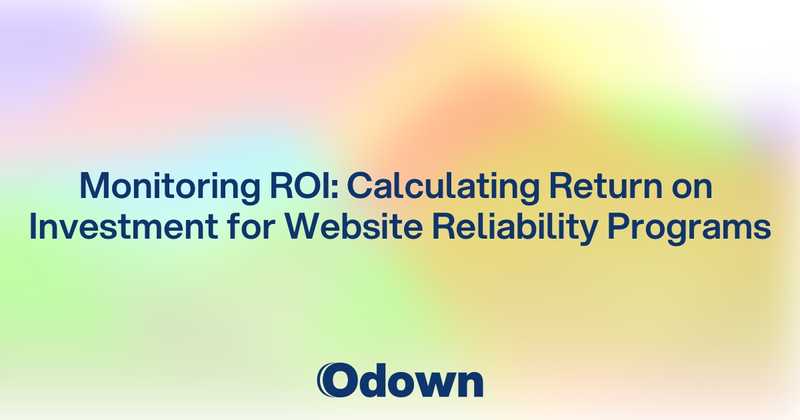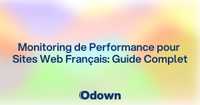Monitoring ROI: Calculating Return on Investment for Website Reliability Programs
Your CEO just asked you to justify the $50,000 annual spend on monitoring tools, and you realize you've never calculated the actual return on investment. Your CFO wants to know why monitoring is worth more than basic server ping checks, but you're struggling to quantify the business value in terms they understand. Your budget for next year depends on proving that comprehensive monitoring actually saves money rather than just costing it.
Most organizations implement monitoring because it seems obviously necessary, but few calculate the actual financial return. Without concrete ROI data, monitoring budgets become easy targets during cost-cutting exercises, and monitoring teams struggle to get resources for improvements.
Calculating monitoring ROI requires understanding both the costs of comprehensive monitoring and the financial impact of the problems it prevents. The math isn't always straightforward, but organizations that can demonstrate clear ROI find it much easier to justify monitoring investments and secure budget for improvements.
Professional monitoring platforms help organizations prevent costly downtime, but the financial value depends on accurately calculating both the cost of outages and the cost of prevention. Building a compelling business case requires translating technical benefits into financial terms that executives understand and care about.
Downtime Cost Calculation: Quantifying Revenue Impact and Business Losses
The foundation of monitoring ROI is understanding what outages actually cost your organization in concrete financial terms that go beyond obvious revenue losses.
Direct Revenue Impact Calculation
For revenue-generating websites and applications, downtime costs can be calculated directly:
E-commerce revenue loss calculation multiplies average hourly sales by outage duration to determine immediate revenue impact. During peak shopping periods like Black Friday, hourly revenue losses can reach hundreds of thousands or millions of dollars for major retailers.
Subscription service impact analysis calculates revenue loss from customers who cancel subscriptions due to service reliability issues. Subscription businesses often underestimate how reliability problems affect long-term customer retention and lifetime value.
Transaction fee revenue loss tracks income lost when payment processing, financial services, or other transaction-based services experience outages. Transaction-based businesses lose both immediate fees and potential future transactions from frustrated customers.
Indirect Business Costs
Many outage costs don't show up immediately in revenue reports but have significant long-term financial impact:
Customer acquisition cost increase occurs when reliability problems damage brand reputation and make marketing less effective. Poor reliability can require significantly higher marketing spend to acquire the same number of customers.
Support cost escalation happens when outages generate support tickets, phone calls, and chat sessions that require staff time and resources. A single major outage can generate thousands of support interactions that cost far more than the immediate revenue loss.
Customer lifetime value reduction occurs when reliability issues cause customers to reduce their engagement, downgrade services, or become more likely to switch to competitors. Lifetime value impact often exceeds immediate revenue losses by significant multiples.
Productivity and Operational Impact
Internal systems outages affect employee productivity and operational efficiency:
Employee productivity loss calculation multiplies affected employee hourly costs by outage duration to determine internal productivity impact. For organizations with thousands of employees, even brief outages can cost tens of thousands of dollars in lost productivity.
SLA penalty calculation tracks contractual penalties for service level agreement violations. B2B companies often face significant financial penalties when their services fail to meet guaranteed uptime levels.
Compliance and regulatory cost analysis includes fines, audit costs, and remediation expenses when outages affect regulated industries or cause compliance violations. Financial services, healthcare, and other regulated industries face substantial costs when outages affect compliance systems.
Monitoring Investment Analysis: Tools, Teams, and Infrastructure Costs
Understanding the total cost of comprehensive monitoring helps calculate accurate ROI and compare different monitoring approaches.
Monitoring Tool and Platform Costs
Different monitoring approaches have different cost structures that affect ROI calculations:
Software licensing costs include subscription fees for monitoring platforms, alerting tools, and analytics systems. Enterprise monitoring platforms can cost tens of thousands of dollars annually but may prevent millions in outage costs.
Infrastructure costs cover servers, storage, and networking required to run monitoring systems. Self-hosted monitoring solutions require infrastructure investment that should be included in ROI calculations.
Integration and customization costs include professional services, custom development, and integration work needed to implement comprehensive monitoring. Implementation costs are often overlooked but can be substantial for complex environments.
Team and Personnel Costs
Monitoring requires human resources that represent significant ongoing costs:
Dedicated monitoring staff costs include salaries, benefits, and training for engineers who manage monitoring systems and respond to alerts. Organizations often underestimate the personnel costs required for effective monitoring.
On-call compensation and overtime costs cover additional compensation for staff who respond to alerts outside normal business hours. On-call costs can be substantial for organizations that require 24/7 monitoring coverage.
Training and certification costs ensure that monitoring staff stay current with evolving tools and best practices. Training investments improve monitoring effectiveness but should be included in total cost calculations.
Opportunity Cost Analysis
Monitoring investments compete with other potential technology investments:
Alternative investment comparison evaluates what else the organization could do with monitoring budget. Understanding opportunity costs helps prioritize monitoring investments against other technology initiatives.
Resource allocation optimization ensures that monitoring investments provide better returns than alternative approaches to improving reliability. Some organizations might benefit more from infrastructure improvements than monitoring enhancements.
Technology debt consideration accounts for the long-term costs of delaying monitoring improvements. Poor monitoring can create technical debt that becomes more expensive to address over time.
Business Case Development: Presenting Monitoring Value to Executives
Building compelling business cases requires translating technical monitoring benefits into language and metrics that executives understand and care about.
Executive Communication Strategies
Different executives care about different aspects of monitoring value:
Revenue protection messaging emphasizes how monitoring prevents lost sales and protects existing revenue streams. Revenue-focused messaging works well for CEOs and sales executives who prioritize growth and customer satisfaction.
Cost avoidance presentation highlights how monitoring prevents expensive outages, reduces support costs, and minimizes operational inefficiencies. Cost-focused messaging appeals to CFOs and operations executives who prioritize efficiency and cost control.
Risk mitigation framing positions monitoring as insurance against reputation damage, compliance violations, and competitive disadvantage. Risk-focused messaging works well for boards and executives who prioritize organizational stability and risk management.
Financial Justification Models
Different financial models work better for different types of organizations and monitoring investments:
Payback period calculation determines how quickly monitoring investments pay for themselves through prevented outages and improved efficiency. Short payback periods make monitoring investments easier to justify and approve.
Net present value analysis accounts for the time value of money and long-term benefits when evaluating monitoring investments. NPV analysis works well for large monitoring investments with benefits that accrue over multiple years.
Break-even analysis identifies the minimum number or severity of outages that monitoring must prevent to justify its cost. Break-even analysis helps executives understand the threshold for monitoring value creation.
Success Metrics and KPIs
Effective business cases include measurable success criteria that can be tracked over time:
Uptime improvement targets specify concrete reliability improvements that monitoring investments should achieve. Uptime targets provide clear success criteria that can be measured and reported.
Mean time to recovery reduction measures how monitoring investments improve incident response speed and effectiveness. MTTR improvements often provide significant cost savings that justify monitoring investments.
Customer satisfaction correlation tracks how monitoring improvements affect customer experience and satisfaction scores. Customer satisfaction improvements often provide business value that exceeds direct financial returns.
ROI Measurement: Tracking Monitoring Success and Continuous Improvement
Measuring actual monitoring ROI requires ongoing tracking of both costs and benefits to validate investment decisions and guide future improvements.
Outage Prevention Tracking
Documenting prevented outages helps quantify monitoring value:
Near-miss incident analysis identifies situations where monitoring prevented outages that would have occurred without early warning systems. Near-miss tracking helps quantify the value of proactive monitoring.
Early detection value calculation measures how much monitoring reduces outage duration by enabling faster response. Early detection often provides more value than outage prevention by minimizing the impact of inevitable problems.
Capacity planning benefits track how monitoring data helps prevent outages through better resource planning and capacity management. Capacity planning benefits often provide substantial ROI that's easy to overlook.
Operational Efficiency Improvements
Monitoring often improves operational efficiency in ways that provide measurable financial value:
Automation enablement tracks how monitoring data enables automated responses that reduce manual work and improve response times. Automation benefits often provide ongoing value that accumulates over time.
Resource optimization measurement evaluates how monitoring helps optimize infrastructure utilization and reduce waste. Resource optimization can provide substantial cost savings that justify monitoring investments.
Process improvement tracking measures how monitoring insights help improve operational processes and reduce inefficiencies. Process improvements often provide value that extends beyond immediate outage prevention.
Long-term Value Assessment
Monitoring ROI often includes long-term benefits that aren't immediately obvious:
Brand reputation protection measures how reliable service delivery protects and enhances brand value. Reputation protection benefits are difficult to quantify but can be substantial for customer-facing businesses.
Competitive advantage assessment evaluates how superior reliability helps differentiate from competitors and win business. Competitive advantages from reliability can provide significant long-term value.
Innovation enablement tracking measures how reliable infrastructure enables new products, services, and business models. Innovation benefits often provide the highest long-term ROI from monitoring investments.
Building strong monitoring ROI cases requires understanding both technical capabilities and business impact. Space technology web services monitoring demonstrates how specialized industries calculate ROI for mission-critical monitoring requirements.
Ready to build a compelling business case for your monitoring investments? Use Odown to demonstrate clear ROI through reliable uptime monitoring that prevents costly outages and protects your revenue streams with measurable results.



